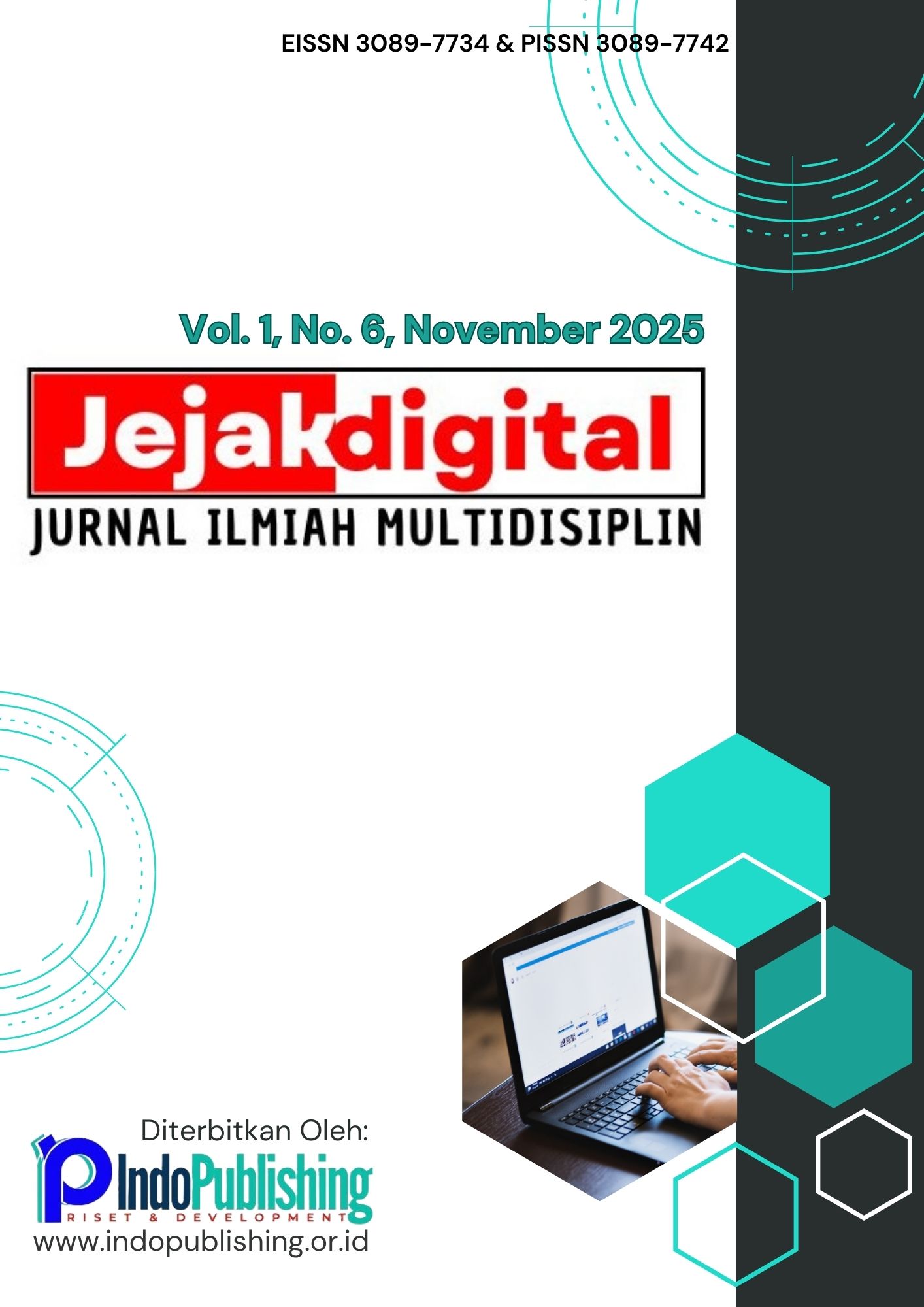Penerapan Pembelajaran SAINS di Era Digital:Microsite Berbasis Deep Learning dan TPACK pada Materi Penegenalan Panca Indera untuk Siswa SD Kelas IV
DOI:
https://doi.org/10.63822/vc9z5c36Keywords:
Panca Indera ,IPA,TEKNOLOGI,modul ajar ,PraktikumAbstract
Science learning in elementary schools needs to be designed contextually so that students understand the five senses from an early age, with the aim of health education. Teaching modules are developed with five senses material through a Technological Pedagogical Content Knowledge (TPACK) approach. This module provides an understanding of the five senses (Content Knowledge) with a pedagogical strategy based on Problem Based Learning (Pedagogical Knowledge) applied to encourage sensory exploration in students' learning experiences.The five senses teaching aids which include visualization of the eyes, nose, tongue, ears, and skin, are expected to improve students' understanding of the material being taught. Then, the use of technology such as learning videos and digital evaluation (Technological Knowledge) increases student involvement in understanding the importance of maintaining health from an early age. This study uses the Research and Development (R&D) method with the ADDIE model (Analysis, Design, Development, Implementation, and Evaluation). The trial was conducted in 4th grade elementary school involving teachers and students. The results showed that this module was effective in improving students' understanding of the concept of the five senses and their awareness of the importance of maintaining their sense organs. The integration of TPACK in the module allows students to gain a deeper learning experience through the use of technology as an aid. Thus, this module becomes an alternative in learning science and increases learning effectiveness through an optimal combination of content, educational materials, and technology.
References
Ainsworth, S. (2006). DeFT: A conceptual framework for considering learning with multiple representations. Learning and Instruction. https://doi.org/10.1016/j.learninstruc.2006.03.001
Akmalia, R., Situmorang, M. S., Anggraini, A., Rafsanjani, A., Tanjung, A., & Hasibuan, E. E. (2023). Penerapan Pembelajaran Berbasis Budaya dalam Meningkatkan Mutu Pendidikan Di SMP Swasta Pahlawan Nasional. Jurnal Basicedu.https://doi.org/10.31004/basicedu.v7i6.6373
Apriliyanti, P., Irmayanti, D., & Alam, S. (2023). Perancangan UI/UX Aplikasi Media Pembelajaran Pengenalan Budaya Indonesia Untuk Siswa Sekolah Dasar Menggunakan Metode User Centered Design (UCD). Jurnal Teknologi Informatika Dan Komputer. https://doi.org/10.37012/jtik.v9i2.1665
Barrows, H. (2002). Is it truly possible to have such a thing as dPBL? In Distance Education. https://doi.org/10.1080/01587910220124026
Branch, R. M. (2010). Instructional design: The ADDIE approach. In Instructional Design: The ADDIE Approach.https://doi.org/10.1007/978-0-387-09506-6
Creswell, J. W. (2020). Penelitian Kualitatif & Desain Riset : Memilih di Antara Lima Pendekatan. In Mycological Research. Dewey, J. (2022). Experience and education. In Foundations of Education: Essential Texts and New Directions. https://doi.org/10.4324/9781003340362-9
Gay, G. (2010). Culturally Responsive Teaching: Theory, Research, and Practice. Teachers College. https://books.google.co.id/books?id=rYspC7C-zowC
Hmelo‐Silver, C. E., Bridges, S. M., & McKeown, J. M. (2019). Facilitating Problem‐Based Learning. In The Wiley Handbook of Problem‐Based Learning. https://doi.org/10.1002/9781119173243.ch13
Illing, H. A., & Piaget, J. (1955). The Construction of Reality in the Child. The Journal of Criminal Law, Criminology, and Police Science. https://doi.org/10.2307/1139430
Koehler, M. J., Mishra, P., & Cain, W. (2013). What is Technological Pedagogical Content Knowledge (TPACK)? Journal of Education.https://doi.org/10.1177/002205741319300303
Lickona, T. (2013). Educating for Character in the Sexual Domain. In Peabody Journal of Education. https://doi.org/10.1080/0161956X.2013.775873
Mariyati, L. I. (2021). Modul Praktikum Individual/Klasikal Tes Inventory.In Modul Praktikum Individual/Klasikal Tes Inventory.https://doi.org/10.21070/2021/978-623-6081-27-3
Mayer, R. E. (2010). Applying the science of learning to medical education. Medical Education. https://doi.org/10.1111/j.1365-2923.2010.03624.x
Mayer, R. E. (2014). The Cambridge handbook of multimedia learning, second edition. In The Cambridge Handbook of Multimedia Learning, Second Edition. https://doi.org/10.1017/CBO9781139547369
Mishra, P., & Koehler, M. J. (2006). Technological pedagogical content knowledge: A framework for teacher knowledge. In Teachers College Record. https://doi.org/10.1111/j.1467-9620.2006.00684.x
Najib, M. A., & Maunah, B. (2022). INOVASI PENDIDIKAN DI ERA DIGITAL (STUDI PELAKSANAAN PEMBELAJARAN DI JENJANG SD-SMP KABUPATEN TULUNGAGUNG). Tadbir: Jurnal Manajemen Pendidikan Islam.https://doi.org/10.30603/tjmpi.v10i1.2462
Nurul Mahruzah Yulia, Suttrisno, Zumrotus Sa’diyah, & Durrotun Ni’mah. (2023). PENDIDIKAN KARAKTER SEBAGAI UPAYA WUJUDKAN PROFIL PELAJAR PANCASILA. Jurnal Ilmiah Pendidikan CitraBakti.https://doi.org/10.38048/jipcb.v10i2.1204
Paivio, A. (2008). Mental Representations: A dual coding approach. In Mental Representations: A Dual Coding Approach.https://doi.org/10.1093/acprof:oso/9780195066661.001.0001
Rahayu, S. J., Sukarmin, S., & Karyanto, P. (2019).PENERAPAN MODEL PEMBELAJARAN BERBASIS PROYEK PADA SEKOLAH MENENGAH PERTAMA DI SURAKARTA. EDUSAINS. https://doi.org/10.15408/es.v11i2.1135
Rasmawan, R. (2017). PROFIL KETERAMPILAN KERJA ILMIAH DAN BERPIKIR KRITIS SISWA SMA DI KALIMANTAN BARAT. EDUSAINS. https://doi.org/10.15408/es.v9i1.4417
Sari, D. A., & Supriyadi, S. (2021). Penguatan literasi budaya dan kewargaan berbasis sekolah di sekolah menengah pertama. Jurnal Citizenship: Media Publikasi Pendidikan Pancasila Dan Kewarganegaraan.https://doi.org/10.12928/citizenship.v4i1.19409
Setiawan, A. (2020). HUBUNGAN KEBIASAAN BELAJAR DAN DISIPLIN BELAJAR DENGAN HASIL BELAJAR IPS. Joyful Learning Journal. https://doi.org/10.15294/jlj.v9i1.39136
Shulman, L. S. (2019). Those who understand: Knowledge growth in teaching. Profesorado.https://doi.org/10.30827/profesorado.v23i3.11230
Downloads
Published
Issue
Section
License
Copyright (c) 2025 Dhuwi Noviyanti, Hidayah Indah Paramesthi, Luthfiana Permata Bunda, Mayla Fara Azzahra, Nanda Lina Oryza Septiviana, Nazwa Nur Fadhila, Oktaviana Eka Rahmadani, Liss Dyah Dewi Arini (Author)

This work is licensed under a Creative Commons Attribution-NonCommercial-ShareAlike 4.0 International License.






